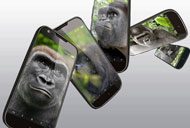Corning’s Gorilla Glass 5 mobile device display glass has gotten even stronger, with improvements that allow the glass to survive falls on asphalt and concrete about 80 percent of the time from about 5.24 feet in height.
That’s a significant improvement from Corning’s Gorilla Glass 4 product, which would survive falls up to 3.28 feet on asphalt or concrete about 80 percent of the time. The new Gorilla Glass 5 has 1.8 times the performance of Gorilla Glass 4 for break resistance.
Corning announced its latest Gorilla Glass 5 coverings on July 20 and will begin appearing on device displays in the near future, Jim Steiner, the senior vice president and general manager of Corning Specialty Products, told eWEEK. Improvements in display glass drop durability is the top concern of mobile device users based on surveys conducted for Corning, said Steiner.
Corning began working harder to increase the drop survivability of its device glass, starting with Gorilla Glass 4 when it was released in November 2014, said Steiner. By investigating how device glass shattered for consumers, the company’s engineers were able to figure out what caused the failures and began making additional improvements in the composition of the glass and in its strengthening processes, he said.
The findings led researchers to learn that asphalt and concrete are particularly tough on device screens and lead to higher breakage rates because they have surfaces with many “sharp contact angles” that cause breakage upon impacts, he said. Surfaces such as granite or stainless steel have smoother profiles and caused no screen breakage incidents from impacts in Corning’s tests.
“The profile of asphalt [under a microscope] looks more like sandpaper and has sharper surfaces than even concrete,” which is what causes a higher rate of drops on such materials, said Steiner.
Corning strengthens Gorilla Glass through an ion exchange process, he said. The raw Gorilla Glass is placed in a potassium salt bath and it exchanges ions of potassium for ions of salt that are in the raw glass. Each potassium ion is larger than each sodium ion, which makes the glass stronger because, once treated, it contains fewer fissures between fewer ions, resulting in fewer areas where breakage can occur, he said.
Typical window glass, also called soda lime glass, has much less resistance to breakage, said Steiner. If typical window glass is dropped from 5 feet, it “fails 100 percent of the time,” compared to the 80 percent survivability rate of Gorilla Glass 5.
Drops from lower heights with Gorilla Glass 5, say 2 to 3 feet, have much higher survival rates, he added.
“We didn’t see a [glass] failure until about 2.29 feet” onto asphalt under the company’s tests, said Steiner.
Corning tests the glass using a simulated smartphone by dropping it by 10 centimeter increments onto a hard surface covered with sandpaper, which simulates the sharp destructive angles of asphalt. Actual asphalt can’t be used because it “gives” and is smoothed out each time a device is dropped on it, reducing its breakage effectiveness with each drop, he said.
A global study done for Corning showed that more than 85 percent of smartphone owners have dropped their phones at least once per year and 55 percent have dropped their phones three times or more, according to the company.
“With each successive generation of Corning Gorilla Glass, we have taken cover glass technology to new levels,” John Bayne, vice president and general manager of Corning Gorilla Glass, said in a statement. “Gorilla Glass 5 is no exception, extending Corning’s advantage in drop performance over competitive glasses. With many real-world drops occurring from between waist and shoulder height, we knew improving drop performance would be an important and necessary advancement.”
Corning Gorilla Glass has been used on more than 4.5 billion devices worldwide since it was launched in 2007, including more than 1,800 product models across 40 major brands, such as Samsung, BlackBerry, ZTE, Motorola, Microsoft, LG and Acer, according to Corning.
When Gorilla Glass 4 was released in November 2014, Corning said it was at least two times stronger than existing screen surfaces from competitors, according to an earlier eWEEK story.
